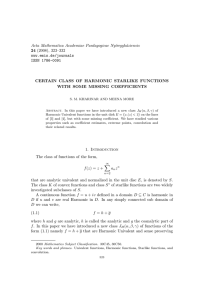Document 10813157
advertisement
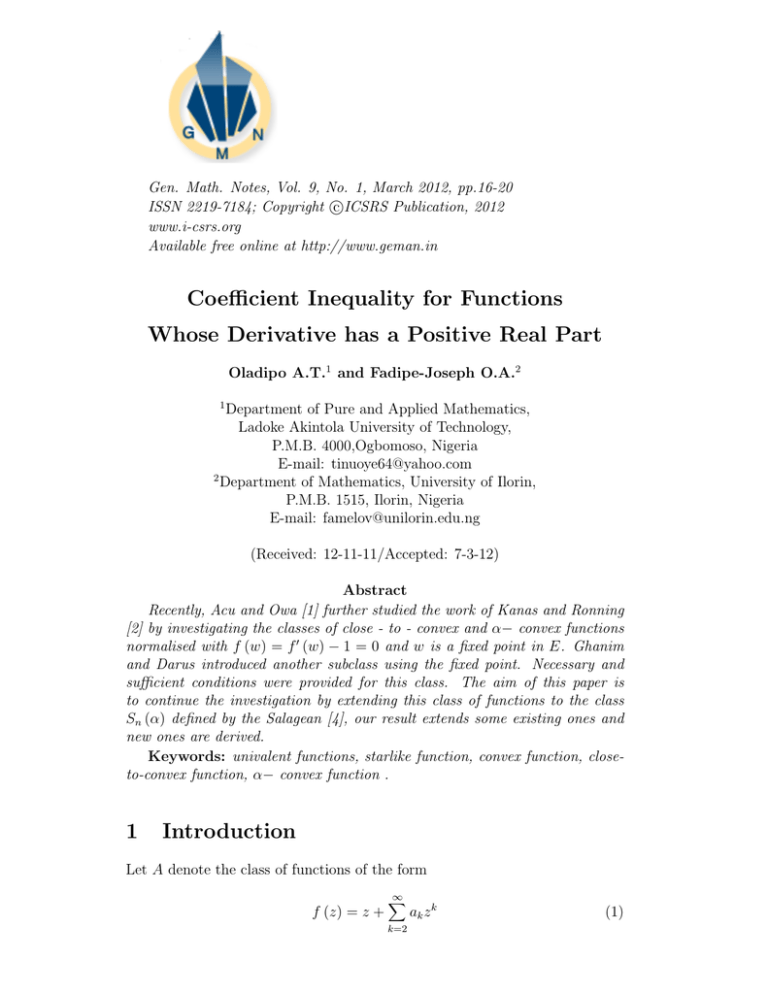
Gen. Math. Notes, Vol. 9, No. 1, March 2012, pp.16-20
c
ISSN 2219-7184; Copyright ICSRS
Publication, 2012
www.i-csrs.org
Available free online at http://www.geman.in
Coefficient Inequality for Functions
Whose Derivative has a Positive Real Part
Oladipo A.T.1 and Fadipe-Joseph O.A.2
1
Department of Pure and Applied Mathematics,
Ladoke Akintola University of Technology,
P.M.B. 4000,Ogbomoso, Nigeria
E-mail: tinuoye64@yahoo.com
2
Department of Mathematics, University of Ilorin,
P.M.B. 1515, Ilorin, Nigeria
E-mail: famelov@unilorin.edu.ng
(Received: 12-11-11/Accepted: 7-3-12)
Abstract
Recently, Acu and Owa [1] further studied the work of Kanas and Ronning
[2] by investigating the classes of close - to - convex and α− convex functions
normalised with f (w) = f 0 (w) − 1 = 0 and w is a fixed point in E. Ghanim
and Darus introduced another subclass using the fixed point. Necessary and
sufficient conditions were provided for this class. The aim of this paper is
to continue the investigation by extending this class of functions to the class
Sn (α) defined by the Salagean [4], our result extends some existing ones and
new ones are derived.
Keywords: univalent functions, starlike function, convex function, closeto-convex function, α− convex function .
1
Introduction
Let A denote the class of functions of the form
f (z) = z +
∞
X
k=2
ak z k
(1)
17
Coefficient Inequality for Functions...
which are analytic in the unit disk E = [z = |z| < 1]. Let S ⊂ A be the class
of functions univalent in E
Here we recall the following definitions of the well known classes of starlike,
convex,
n close-to-convex
h 0 iand α− convex
o functions.
(z)
S ∗ = f ∈ A : Re zff (z)
> 0, z ∈ E
n
h
S c = f ∈ A : Re 1 +
n
zf 00 (z)
f 0 (z)
∗
i
z∈E
> 0,
h
0
o
i
o
(z)
CC = f ∈ A : ∃ g ∈ S , Re zfg(z)
> 0, z ∈ E
Let w be a fixed point in E and A (w) = {f ∈ A (w) : f (w) = f 0 (w) − 1 = 0}
The following classes were introduced in [2] and further studied in [1]
S (w) = {f ∈ A (w) n: f ∈ S}
h
i
o
0 (z)
ST (w) = S ∗ (w) = f ∈ S (w) : Re (z−w)f
>
0,
z
∈
E
f (z)
n
h
CV (w) = S c (w) = f ∈ S (w) : Re 1 +
See details in [1].
2
(z−w)f 00 (z)
f 0 (z)
i
> 0, z ∈ E
o
Preliminary Notes
Let p (w) denote the class of all functions
p (z) = 1 +
∞
X
Bk (z − w)k
(2)
k=1
that are regular in E and satisfying p (w) = 1 and Rep (z) > 0 for z ∈ E,
where
2
|Bk | ≤
(3)
(1 + d) (1 − d)k
and d = |w| and k ≥ 1. See [1, 2, 3].
Definition 1.1 [4]: A function f (z) ∈ A (w) is said to be in the class Snw (α) if
and only if
Re
Dn+1 f (z)
>α
Dn f (z)
(4)
where 0 ≤ α < 1, n = 0, 1, 2, 3, . . . and z ∈ E and Dn is the Salagean differential operator and it is defined as follows:
0
D0 f (z) = f (z) , D0 f (z) = zf 0 (z) , . . . , Dn f (z) = z (Dn−1 f (z))
3
Main Results
These are the main results of the paper.
18
Oladipo A.T. et al.
Theorem 3.1. Let f ∈ Snw (α) and f (z) = (z − w) +
Then
1−α
|a2 | ≤ n−1
2
(1 − d2 )
P∞
ak (z − w)k .
(5)
(1 − α) (1 + d) + 2 (1 − α)2
3n (1 − d2 )2
(6)
2 (1 − α) (1 + d)2 + 2 (1 − α)2 (5 + 3d − 2α)
3.4n (1 − d2 )3
(7)
|a3 | ≤
|a4 | ≤
k=2
3 (1 − α) (1 + d)3 + 11 (1 − α)2 (1 + d)2 + 4 (1 − α)3 (4 + 3d − α)
|a5 | ≤
(8)
2.3.5n (1 − d2 )4
where d = |w|
Proof. Let us define
Dn+1 f (z)
Dn f (z)
−α
1−α
= p (z)
(9)
From equation(9) we have
Dn+1 f (z) − αDn f (z)
= p (z)
(1 − α) Dn f (z)
(10)
Dn+1 f (z) = αDn f (z) + (1 − α) Dn f (z) p (z)
(11)
which readily yields
On comparing the coefficients in equation (11) the results follows.
Remarks Putting α = 0 and n = 0 in the results of Theorem 3.1 above,
we obtain the coefficient bounds of Kanas and Ronning [2] immediately. With
different choices of α and n different coefficients bounds can be obtained.
Theorem 3.2. Let f ∈ Snw (α) . Then,
|a3 −
|a2 a4 −a23 | ≤
µa22 |
(1 − α) (1 + d) + 2 (1 − α)2
µ (1 − α)2
≤
− 2(n−1)
3n (1 − d2 )2
2
(1 − d2 )2
(12)
(1 − α)2 (1 + d)2 + (1 − α)3 (5 + 3d − 2α) (1 − α)2 (1 + d)2 + 4 (1 − α)4
−
3.23n−2 (1 − d2 )4
32n (1 − d2 )4
(13)
19
Coefficient Inequality for Functions...
where µ ≥ 1
Proof. The proof is immediate from Theorem 3.1
Theorem 3.3. Let w be a fixed point in E and f ∈ Snw (α) and
f (z) = (z − w) +
∞
X
bk (z − w)k
(14)
k=2
with respect to function g (z) ∈ S ∗ (w), where
g (z) = (z − w) +
∞
X
ak (z − w)k
(15)
k=2
Then,
k−1
X
1 n
2 (1 − α)
|bk | ≤ n+1 k |ak | +
(k − ρ)n |ak−ρ |
k
(1 + d) (1 − d)k−ρ
ρ=1
(16)
where d = |w|, k ≥ 2 and aρ = 1
Proof. Let f ∈ Snw (α) with respect to the function g ∈ S ∗ (w)
Then there exists a function p ∈ P (w) such that
Dn+1 f (z)
Dn g(z)
−α
1−α
= p (z)
(17)
k
where p (z) = 1 + ∞
k=1 Bk (z − w)
Using the hypothesis through identification of (z − w)k coefficients, we have
P
k n+1 bn = k n ak +
k−1
X
(1 − α) (k − ρ)n ak−ρ Bk−ρ
(18)
ρ=1
where a1 and k ≥ 2. From equation(18) we have the result.
Remarks If we use the estimates in Theorem 3.1, we obtain some estimates
for the coefficients bk , k = 2, 3, 4, . . .. Also, at α = 0, n = 0, we obtain the
results of Acu and Owa [2].
Acknowledgements
The second author’s work was completed while the author was a visiting researcher at the African Institute of Mathematical Sciences, South Africa.
20
Oladipo A.T. et al.
References
[1] M. Acu and S. Owa, On some subclasses of univalent functions, Journal of
Inequalities in Pure and Applied Mathematics, 6(Issue 3) (2005), Article
70, 1-14.
[2] S. Kanas and F. Ronning, Uniformly starlike and convex functions and
other related classes of univalent functions, Ann. Univ. Mariae Curie
Sklodowska, section A(53) (1991), 95-105.
[3] F. Ghanim and M. Darus, On new subclass of analytic univalent function
with negative coefficient II, Inter. Journal of Math. Analysis, 2 (2008),
893-906.
[4] G.S. Salagean, Subclasses of univalent functions, Complex Analysis - Fifth
Romanian Finish Seminar, Bucharest, 1(1981), 362-372.
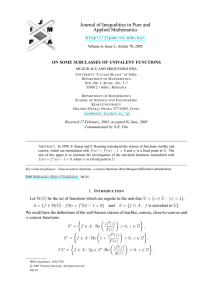
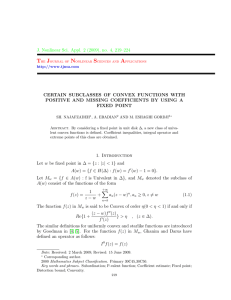
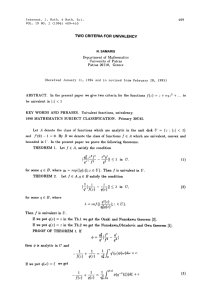
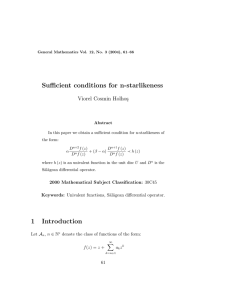

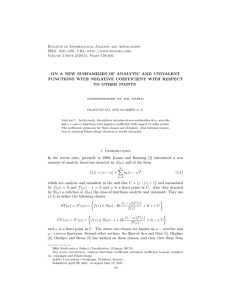

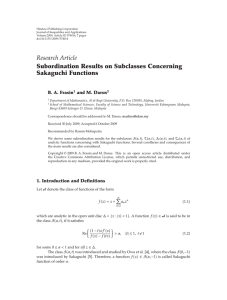
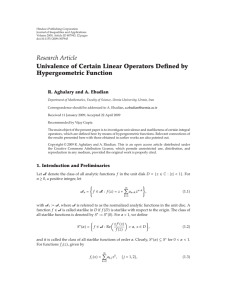
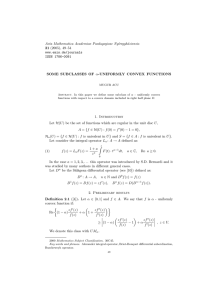
![Re[zf"(z)/f`(z) + 1] > 0, z £ U => Re[zf`(z)/f(z)} >\, z](http://s2.studylib.net/store/data/018544291_1-0b7f586d7468ffb3ff58343cf618263c-300x300.png)
